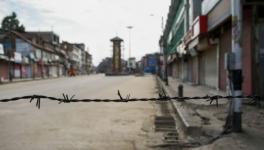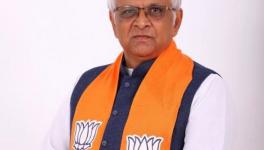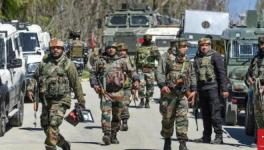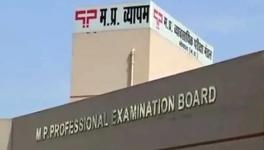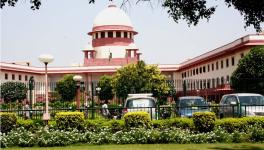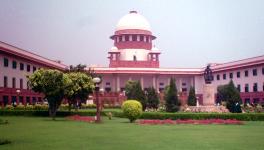Gujarat Encounters 2002-07: Justice Bedi Report Finds Foul Play In 3 Cases
Image for representational use only; Image Courtesy : Odisha Sun Times
There is prima facie evidence of foul play in three out of 17 cases of encounter killings in Gujarat which took place between 2002 to 2007, states the report filed by Justice (Retd) H S Bedi in the Supreme Court. He has recommended prosecution of nine police officers involved in the cases.
It was on March 2, 2012 that the Supreme Court appointed Justice Bedi, a former SC judge, as Chairman of the Monitoring Committee, to monitor the investigation carried out by the Special Task Force (STF) constituted by the Gujarat government to investigate the cases of custodial deaths. The report is only regarding the 17 cases which were specifically referred to STF.
The SC intervention came in the petitions filed by journalist B G Verghese (since expired), poet-lyricist Javed Akhtar and social worker Shabnam Hashmi, who alleged that the police encounters were fake and stage-managed.
Justice Bedi submitted his report in the Court in sealed cover on February 26, 2018. Earlier this week, on January 9, the CJI-led bench of the SC ordered to make the report public, overruling the objections of Gujarat government.
Live Law has accessed a copy of the report, which recommends prosecution of officers involved in the custodial deaths of Kasam Jafar, Haji Haji Ismail and Sameer Khan. Justice Bedi has also ordered grant of compensation to the next of kin of the deceased.
Sameer Khan
The most striking case is that of Sameer Khan, who was in his 20s when he was killed in an encounter. As per police version, he was a terrorist, who had come to Gujarat to assassinate the then Chief Minister Narendra Modi.
According to his father, Sarfaraz Khan, Sameer Khan was a rickshaw-puller.
The police account is as follows: Sameer Khan had allegedly absconded after stabbing a police constable in 1996. He got later involved with terrorist organisation Jaish-e-Mohammed and had managed to go to Pakistan on a fake passport.
He returned to Gujarat with an alleged plan to assassinate Narendra Modi, the then CM of Gujarat. But he was arrested by police in Ahmedabad on September 30,2002. After his arrest, he was taken to the site, where he had allegedly stabbed the constable in 1996, for investigation of that crime. There he managed to get out of his handcuffs and snatched a revolver from Inspector K M Vaghela and opened fire. When police returned fire in defence, he got killed. This incident occurred on October 22, 2002.
Justice Bedi rejected the police account wholly. He found it hard to believe that a "dreaded terrorist", who was on an alleged mission to assassinate the CM, was handcuffed so loosely. "This appears to have been done deliberately so as to make out a plausible story to justify the killing", he said in the report.
He also noted that the all courts, including the Supreme Court, had disbelieved the theory of assassination plot against CM, and had discharged the other 15 men who were accused of being part of the conspiracy.
Justice Bedi further rejected the police version that Sameer Khan had gone to Pakistan for training in terror outfit. The police claimed that Sameer had travelled to Pakistan in January 1998, but the passport on which was supposed to have travelled was issued only issued on March 27, 1998, that too in the name of one Nawab Khan. But there is no record of any person by the name of Nawab Khan travelling to Pakistan on the said date.
The bullet wounds in the dead body were also found to have blackened, suggesting firing from a close range. He was shot at his chest and head. From a reconstruction of the crime scene, it appeared that the deceased and police officers were standing face to face. The bullet trajectory in the head injury suggested that firing was down from top to bottom.
The report recommended that Inspector KM Vaghela and Inspector TA Barot should be prosecuted for murder and other relevant offences. Compensation of Rs.10 lakh was ordered to be paid to the father of Sameer Khan.
It may be relevant to note that Vaghela was questioned by CBI in the Sohrabuddin Sheikh case, though not charge-sheeted. Barot is an accused in the alleged fake encounter case of Ishrat Jahan.
Allegations Against Higher Officials
Sarfaraz Khan had made allegations against higher officials of Gujarat police for covering up the fake encounter. He relied on the revelations made by Thirth Raj, IG of Police, in a sting operation by Tehelka in 2007 that DSP Yadav had concluded that the incident was stage-managed, but was prevented from filing final report due to external political pressure. Raj further stated in the sting that records of the case were destroyed on instructions from the then Home Minister and DGP.
Justice Bedi chose not to delve deep into these issues in view of the "limited mandate" of the Monitoring Committee to determine whether the encounter killings were fake. "I am not called upon to comment on all allegations made by Sarfaraz Khan or on all the answers made by Thirth Raj", he said in the report.
The recording was used to find support for the conclusion that his killing was a "result of fake encounter".
Expressing empathy with the "tortous and agonizing journey" of Sarfaraz Khan for having lost his son, Justice Bedi ordered grant of Rs.10 lakh compensation to him.
Haji Haji Ismail
Haji Haji Ismail was killed in a gunfire by police during the wee hours of October 9, 2005 on the Mumbai-Ahmedabad highway.
According to the police, he was a notorious smuggler, and the police had set up a plan to nab him on getting information that he was travelling to Mumbai by road during the early hours of October 9. The police signalled the vehicle of Ismail to stop. Soon after stopping the vehicle, Ismail started fire at police. In the resultant fire exchange, he got killed.
Justice Bedi found the police version to be suspicious for the following reasons:
Five bullet wounds on his body were blackened. Blackening of bullet wounds will happen if firing is done from close range, from a distance of two feet or so. Reference was made to Dr. Modi's book on Medical Jurisprudence and Toxicology to arrive at this conclusion.
There was no sign of nitrite in the hand-wash sample of the deceased. This led to the inference that the deceased had not used any fire arm.
The post-mortem report revealed that the distance between the weapons and the deceased was at the most 2 feet,s uggestive of a custodial killing.
There was nothing on record to show that the deceased was a notorious smuggler.
"The fact that as many as 20 rounds had been fired at the deceased from almost point blank range are indicative of a cold blooded murder", Justice Bedi said.
The report, therefore, recommended that the officers involved - Inspector KG Erda, PSI LB Monpara, PSI JM Yadav, PSI SK Shah and PSI Prag P Vyas – should be brought to trial for murder and other offences.
Kasam Jafer
Kasam Jafer was taken into custody by the Ahmedabad police on April 13, 2006 along with 17 others, on suspicion of being part of the crime syndicate "Irani Gang".
As per the police version, Kasam Jafar "disappeared" from the Police Head Quarters building on April 13 night. During the wee hours of April 14, his dead body was found under a bridge at another place. The police stated that he was hit by a motor vehicle while he was on the run.
His widow Mariam Jaffer was suspicious of the police version. She denied that her husband was part of any criminal gang and said that her husband and her friends had stopped at Ahmedabad en route their pilgrimage from Mumbai to Husseini Tekari. She filed an application in the High Court seeking investigation into Jafer's death with the aid of activist Teesta Setalvad. This case was later taken up by the STF.
Justice Bedi found the police version to be "unbelievable". The Police Head Quarters was a fortress, and it was not possible for a person to escape from the building easily. If the arrested persons belonged to the notorious "Irani Gang", the police would not have been careless in security. According to police version, it was the negligence of Constable Ganesh Bhai which led to the escape of Jaffer. However, no departmental action was taken against him for the lapse.
Justice Bedi also found it strange that the other 17 persons, who were taken into custody along with Jaffer, were not informed about his escape and subsequent death. Rather, police had let them go on April 14 early morning, with a warning that they should not set foot in Gujarat again.
Also, the post mortem report suggested that Jaffer died due to "external and internal injuries shock and hemorrhage", caused by a "hard and blunt substance". The police had made several attempts to get the doctors clarify that the cause of death was an accident.
The very conduct of the police officers is so unnatural that it raises very great suspicions about what had happened in the matter", said the report.
"Reluctance of police to inform the relatives and family members of the deceased that he had met with an accidental death, clearly betrays a guilty mind", the report further said. Justice Bedi also found that there was no evidence to indicate that Jaffer and his companions were involved in part of any criminal gang.
Justice Bedi has recommended action only in cases where: the police version seemed to be deeply suspicious and difficult to believe the evidence was of a quality that in case a trial was held there was a reasonable chance of conviction
The report has indicted only lower level police officials who were present at the spot of the crime. However, it states : "If during the course of trial the evidence reveals that some others were also involved in any manner whatsoever, they too would be indicted and tried as per law"
The 229-page report suggested closure of other 14 cases in the absence of cogent evidence to contradict police version. The victims of 17 cases belonged to several parts of India, as far as Uttarakhand, Uttar Pradesh, Madhya Pradesh, Kerala, Bihar and Maharashtra, and belonged to several communities. The only common feature between them was the element of criminality of varying levels and degrees, the report said.
On this basis, the report rejected the allegation of selective targeting of Muslims raised by R B Sreekumar IPS, former DGP of Gujarat Police, who had resigned from service. He deposed before the Committee that oral instructions used to be issued to police officials to carry out fake encounters against Muslim extremists.
He stated that he was constrained to resign from his service as he found it difficult to follow such instructions. Justice Bedi chose not to act upon the statement of Sreekumar, as they were too "general in nature" not specifically dealing with 17 cases under the probe of STF.
There were objections raised by Shabnam Hashmi against AK Sharma IPS acting as the STF Chief, on the ground that he was proximate to top echelons of power, including the then CM Narendra Modi. Justice Bedi rejected those objections, terming them "vague allegations". He also added that he had no power to change the STF.
Get the latest reports & analysis with people's perspective on Protests, movements & deep analytical videos, discussions of the current affairs in your Telegram app. Subscribe to NewsClick's Telegram channel & get Real-Time updates on stories, as they get published on our website.











